Comparative Evaluation of Mobile Platforms for Non-Structured Environments and Performance Requirements Identification for Forest Clearing Applications
Abstract
1. Introduction
1.1. Usage Scenario
1.2. Selected Mobile Industrial Machines
2. State of the Art
2.1. Forestry
2.1.1. Timber Industry
2.1.2. Fuel Management in Forest Areas
2.2. Forest Management of the Future
2.2.1. Forest Automation Challenges
2.2.2. Robot Swarms
3. Key Metrics for the Development of a Forest Clearing Machine
3.1. Mobility
3.1.1. Locomotion
| Wheels | Tracks | Hybrid | Legs | |
| Evaluation | 2 | 3 | 4 | 5 |
3.1.2. Steering Type
| Conventional | Coordinated steer | Skid steer | Articulated | Independent | |
| Evaluation | 1 | 2 | 3 | 4 | 5 |

3.1.3. Gross Weight
3.1.4. Payload
3.1.5. Turning Radius
3.1.6. Ground Clearance
3.1.7. Max Lateral Slope Angle
3.1.8. Max Climbing Angle
3.1.9. Angles of Approach and Departure
3.2. Power
3.2.1. Propulsion System
| Petroleum-derived fuels | Hybrids | Full-electric | |
| Evaluation | 1 | 3 | 5 |
3.2.2. Operational Range
3.2.3. Battery Technology
- Lithium-ion (Li-ion) batteries have gained substantial improvements in the last decades, first to support portable electronics and more recently to enable cost-effective high performance electric vehicles [52]. The rapid decline in costs is mainly due to a massive increase in production scale and the increase in cell performance, making cells cheaper on a cost/kWh basis. Lithium-ion batteries have high energy density (reaching 250 Wh/kg in 2022), offer a large number of cycles and good thermal and chemical stability, leading to lower life cycle cost when compared to other battery technologies, reason why they are widely applied in electric vehicles.
- Nickel-metal hydride (Ni-MH) batteries, in comparison with lead-acid batteries, have up to double the specific energy and a greater energy density [53]. However, Ni-MH batteries do have disadvantages, such as having lower charging efficiencies than other batteries and a higher self-discharge that is aggravated in a high-temperature environment.
- Solid-state batteries (SSBs) are considered the next-generation energy storage technology [54]. Unlike lithium-ion batteries, SSBs do not need extensive monitoring, cell balancing or cooling systems. They have more energy density (up two times more than lithium-ion batteries), and they are smaller, simpler and lighter energy storage systems. They promise higher energy density, wider operating temperature range and improved safety for electric vehicles. Lithium metal anodes (Li), with sulfide-based solid-state electrolytes (SSE) and nickel-rich cathodes are the most promising compositions. However, the battery cycle life at high cathode mass loading and high current is still limited because the failure mechanism is not fully understood. This is preventing the technology to scale up to the sizes required for electric vehicles [55].
- Lead-acid batteries were the first rechargeable batteries ever made. Although the technology is outdated, it has stood the test of time and is still among today’s most widely used types. It is popular due to its low cost and ability to operate efficiently even at low temperatures, which often prevails over their low energy densities and low life cycle times [56]. Lead-acid batteries also present potential environmental problems if they are not properly disposed of or recycled.
3.2.4. Charging Strategy
3.2.5. Charging Time and Swap Time
3.2.6. Available Power
3.2.7. Hydraulic Power
3.3. Control
Degree of Autonomy
- Manual: This includes the range of machines and tools that depend on the human operator at all levels, from position and attitude control to decision making. The equipment has no ability to give feedback to the operator or adapt to changing conditions. The human operator is at the heart of the operation and therefore at greatest risk while operating the equipment [61].
- Remote-controlled: This involves remote operation by means of a remote control as shown in Figure 7a. It allows the operator to be taken away from the action, which gives him greater protection against any type of dangerous event in the vicinity of the operation [62]. These MPs may have sensors and safety systems that alert the operator to events that may be unknown to him and that may lead to some dangerous operation.
- Operator-assisted autonomy: Operator-assisted autonomy allows operators to focus on the operation as their MIM drives itself. While MIMs are still manned by an operator, guidance technologies help maintain row-to-row MIM accuracy in the field in order to reduce overlaps and skips. This category of automation uses both vehicle and environmental data to develop an information hub [63]. An MIM equipped with ISOBUS Class 3 functionality falls into this category as this technology allows, among others, the control of tractor ground speed and power take-off (PTO) functions. Satellite imagery and soil sampling maps help in the coordination and optimization of in-field path plans, which fall in the category of operator-assisted autonomy. These technologies help save energy, decrease labor costs and reduce operator fatigue while also maximizing efficiency.
- Supervised autonomy: The supervised autonomy category of automation allows providing in-field supervision while the unmanned MIM performs designated tasks [64]. With an unmanned MIM, supervised autonomy takes productivity and efficiency to a new level by enabling would-be-operators to monitor the performance of their MIM while simultaneously accomplishing other strategic, in-field tasks. MIMs with this autonomous capability are equipped with high-precision GNSS and intermediate level sensing and perception to avoid environmental obstacles.
- Full autonomy: Full autonomy is the most advanced category of automation [65]. Full autonomy allows an MIM to be operated with remote supervision—such as from the farm office—or via artificial intelligence control systems. Additionally, an MIM with full autonomy has the ability to account for weather and moisture levels, which serve to further increase productivity and efficiency of the farming operation.
3.4. Perception
3.4.1. Position and Attitude Sensors
3.4.2. Application-Specific Sensors
3.4.3. Awareness and Safety Sensor Systems
3.5. Communications
3.5.1. Internal Communications
3.5.2. External Communications
3.6. Tools or Attachments
3.7. Availability and Price
4. Comparative Analysis of Different Platforms
4.1. Overall Results
4.1.1. Mobility

4.1.2. Power

4.1.3. Control

4.1.4. Perception

4.1.5. Communications
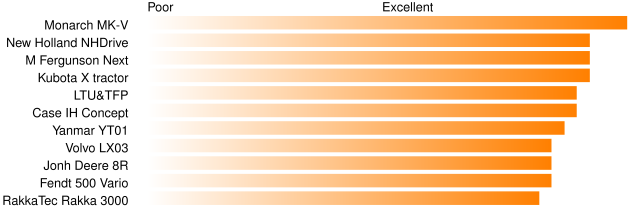
4.1.6. Tools and Attachments

4.1.7. Availability and Price

4.2. Discussion
4.3. Conclusions
| Model | Field of Application | Development Stage | Mobility | Power | Control | Perception | Communications | Tools and Attachments | Availability and Price | Overall |
|---|---|---|---|---|---|---|---|---|---|---|
| AgXeed AgBot | Agriculture | CA | 3.09 | 3.00 | 1.00 | 3.50 | 3.00 | 4.55 | 2.00 | 3.25 |
| Bergmann M201 | Forestry | CA | 3.45 | 3.00 | 1.00 | 2.25 | 2.00 | 4.25 | 2.50 | 2.64 |
| Bobcat T7X | Construction | CA | 3.09 | 3.44 | 2.00 | 1.75 | 2.00 | 2.50 | 2.50 | 2.47 |
| Case IH Concept | Agriculture | IC | 2.64 | 3.20 | 2.00 | 4.06 | 4.25 | 4.25 | 2.50 | 3.27 |
| Energreen Robomax | Forestry | CA | 3.55 | 2.60 | 2.00 | 1.75 | 2.00 | 4.25 | 2.50 | 2.66 |
| Fendt 500 Vario | Agriculture | IC | 2.55 | 2.60 | 2.00 | 4.13 | 4.00 | 4.25 | 2.50 | 3.15 |
| Green Climber LV600 | Forestry | CA | 3.36 | 2.60 | 2.00 | 1.75 | 2.00 | 4.00 | 3.00 | 2.67 |
| H&H Thermite RS1 | Civil protection | CA | 3.27 | 2.60 | 2.00 | 2.00 | 2.00 | 2.50 | 3.00 | 2.48 |
| Hicon HİDROMEK | Construction | IC | 3.09 | 3.89 | 2.00 | 2.50 | 3.00 | 2.75 | 3.00 | 2.89 |
| Jonh Deere 8R | Agriculture | IC | 2.64 | 3.20 | 2.00 | 4.00 | 4.00 | 4.44 | 3.50 | 3.40 |
| Kovaco Elise900 | Construction | CA | 3.36 | 3.67 | 2.00 | 2.75 | 3.00 | 2.50 | 3.50 | 2.97 |
| Kubota X tractor | Agriculture | IC | 2.73 | 4.11 | 2.00 | 4.00 | 4.38 | 4.63 | 3.50 | 3.62 |
| LTU&TFP | Forestry | RD | 3.36 | 3.20 | 2.00 | 3.94 | 4.25 | 4.25 | 4.00 | 3.57 |
| M Fergunson Next | Agriculture | IC | 2.64 | 2.60 | 2.50 | 4.06 | 4.38 | 4.63 | 4.00 | 3.54 |
| McConnel ROBOCUT | Forestry | CA | 3.55 | 2.60 | 3.00 | 1.75 | 3.00 | 4.25 | 4.00 | 3.16 |
| Milrem Multiscope | Multifunctions | CA | 4.09 | 3.67 | 3.50 | 2.50 | 3.00 | 3.00 | 4.00 | 3.39 |
| Monarch MK-V | Agriculture | CA | 2.91 | 4.00 | 3.50 | 4.56 | 4.75 | 4.25 | 4.00 | 4.00 |
| New Holland NHDrive | Agriculture | IC | 2.36 | 3.20 | 3.50 | 4.00 | 4.38 | 4.50 | 4.00 | 3.71 |
| RakkaTec Rakka 3000 | Forestry | IC | 3.91 | 2.80 | 4.00 | 2.50 | 3.88 | 4.25 | 4.25 | 3.65 |
| Raptor 100 | Forestry | CA | 3.36 | 2.80 | 4.50 | 1.75 | 2.00 | 4.25 | 4.38 | 3.29 |
| Shark-Robotics Colossus | Civil protection | CA | 3.36 | 3.22 | 4.50 | 1.75 | 3.00 | 2.25 | 4.50 | 3.23 |
| Volvo LX03 | Construction | IC | 3.45 | 3.78 | 4.63 | 4.19 | 4.00 | 2.75 | 4.50 | 3.90 |
| Yanmar YT01 | Agriculture | IC | 2.91 | 2.80 | 4.88 | 3.00 | 4.13 | 4.50 | 4.63 | 3.83 |
| Zyelektrikli | Agriculture | CA | 2.55 | 3.89 | 5.00 | 2.50 | 3.00 | 4.44 | 4.75 | 3.73 |
| • Tracked locomotion | • Skid steer steering mechanism |
| • Electric power | • Hydraulic actuated |
| • Weight gross between 2500 and 3500 kg | • Minimum payload of 1000 kg |
| • Electric plug for electric-powered attachments | • Remote control with supervised autonomy capabilities |
| • Operating range over 8 h | • Charging time <4 h |
| • Both opportunity charging and swap battery options | • Standardized communication protocols |
| • Standardized coupling for attachments | • Selling price below 70 k (USD) |
Author Contributions
Funding
Data Availability Statement
Conflicts of Interest
References
- Jahn, W.; Urban, J.L.; Rein, G. Powerlines and Wildfires: Overview, Perspectives, and Climate Change: Could There Be More Electricity Blackouts in the Future? IEEE Power Energy Mag. 2022, 20, 16–27. [Google Scholar] [CrossRef]
- Stone, S.L.; Anderko, L.; Berger, M.F.; Butler, C.R.; Cascio, W.E.; Clune, A.; Damon, S.; Garbe, P.; Hauptman, M.; Haskell, W.; et al. Wildfire Smoke: A Guide for Public Health Officials; US Environmental Protection Agency: Washington, DC, USA, 2019. [Google Scholar]
- Turco, M.; Llasat, M.C.; von Hardenberg, J.; Provenzale, A. Climate change impacts on wildfires in a Mediterranean environment. J. Clim. Chang. 2014, 125, 369–380. [Google Scholar] [CrossRef]
- Relatório de Qualidade Serviço. Available online: https://www.e-redes.pt/sites/eredes/files/2020-07/Relat%C3%B3rio%20da%20Qualidade%20de%20Servi%C3%A7o%202019%20vf.pdf (accessed on 15 September 2022).
- Quartau, J.A. Preventative fire procedures in Mediterranean woods are destroying their insect Biodiversity: A plea to the EU Governments. J. Insect. Conserv. 2009, 13, 267–270. [Google Scholar] [CrossRef]
- Viegas, D.X.; Almeida, M.; Ribeiro, L.M.; Raposo, J.; Viegas, M.; Oliveira, R.; Alves, D.; Pinto, C.; Rodrigues, A.; Ribeiro, C.; et al. Análise dos SafeForest/Technical Annex—Call 04/SI/2019 Page 11 of 68 Incêndios Florestais Ocorridos a 15 de Outubro de 2017, Ministério da Administração Interna, Portugal. 2019. Available online: https://bit.ly/2El01IZ (accessed on 15 September 2022).
- Justavino, F.C.; Ramirez, R.J.; Perez, N.M.; Borz, S.A. The use of owas in forest operations postural assessment: Advantages and limitations. Bull. Transylvania Univ. Braşov Ser. Ii: For. Wood Ind. Agric. Food Eng. 2015, 8, 57. [Google Scholar]
- Diniz, C.C.C.; Lopes, E.S.; Koehler, H.S.; Miranda, G.M.; Paccola, J. Comparative Analysis of Maintenance Models in Forest Machines. Floresta Ambiente 2020, 27, e20170994. [Google Scholar] [CrossRef]
- Ziesak, M. Avoiding soil damages, caused by forest machines. In Proceedings of the 2nd Forest Engineering Conference, Vaxjo, Sweden, 12–15 May 2003; pp. 64–73. [Google Scholar]
- Fluchs, S. The diffusion of electric mobility in the European Union and beyond. Transp. Res. Part D Transp. Environ. 2020, 86, 102462. Available online: https://www.sciencedirect.com/science/article/pii/S1361920920306490 (accessed on 15 September 2022). [CrossRef]
- Schippl, J.; Truffer, B. Directionality of transitions in space: Diverging trajectories of electric mobility and autonomous driving in urban and rural settlement structures. Environ. Innov. Soc. Transitions 2020, 37, 345–360. Available online: https://www.sciencedirect.com/science/article/pii/S221042242030126X (accessed on 15 September 2022). [CrossRef]
- Scolaro, E.; Beligoj, M.; Estevez, M.P.; Alberti, L.; Renzi, M.; Mattetti, M. Electrification of Agricultural Machinery: A Review. IEEE Access 2021, 9, 164520–164541. [Google Scholar] [CrossRef]
- Celenta, G.; De Simone, M.C. Retrofitting Techniques for Agricultural Machines. In New Technologies, Development and Application III. NT 2020; Lecture Notes in Networks and Systems; Karabegović, I., Ed.; Springer: Cham, Switzerland, 2020; Volume 128. [Google Scholar] [CrossRef]
- MIM Comparison Table. Available online: https://ipleiria-robotics.github.io/MIM_AC_UGV4FC (accessed on 15 September 2022).
- Billingsley, J.; Visala, A.; Dunn, M. Robotics in Agriculture and Forestry. In Springer Handbook of Robotics; Siciliano, B., Khatib, O., Eds.; Springer: Berlin/Heidelberg, Germany, 2008. [Google Scholar] [CrossRef]
- Abdelsalam, A.; Happonen, A.; Kärhä, K.; Kapitonov, A.; Porras, J. Toward Autonomous Vehicles and Machinery in Mill Yards of the Forest Industry: Technologies and Proposals for Autonomous Vehicle Operations. IEEE Access 2022, 10, 88234–88250. [Google Scholar] [CrossRef]
- Schuh, D.D.; Kellogg, L.D. Timber-Harvesting Mechanization in the Western United States: An Industry Survey. West. J. Appl. For. 1988, 3, 33–36. [Google Scholar] [CrossRef]
- Hellström, T.; Lärkeryd, P.; Nordfjell, T.; Ringdahl, O. Autonomous Forest Vehicles: Historic, envisioned, and state-of-the-art. Int. J. For. Eng. 2009, 20, 31–38. [Google Scholar] [CrossRef]
- Visser, R.; Obi, O.F. Automation and Robotics in Forest Harvesting Operations: Identifying Near-Term Opportunities. Croat. J. For. Eng. 2021, 42, 12. [Google Scholar] [CrossRef]
- Mueller, S.E.; Thode, A.E.; Margolis, E.Q.; Yocom, L.L.; Young, J.D.; Iniguez, J.M. Climate relationships with increasing wildfire in the southwestern US from 1984 to 2015. For. Ecol. Manag. 2020, 460, 117861. Available online: https://www.sciencedirect.com/science/article/pii/S0378112719314744 (accessed on 15 September 2022). [CrossRef]
- Voronova, O.S.; Zima, A.L.; Kladov, V.L. Anomalous Wildfires in Siberia in Summer 2019. Izv. Atmos. Ocean. Phys. 2020, 56, 1042–1052. [Google Scholar] [CrossRef]
- Laushman, K.M.; Munson, S.M.; Villarreal, M.L. Wildfire Risk and Hazardous Fuel Reduction Treatments Along the US-Mexico Border: A Review of the Science (1986–2019). Law Cult. Humanit. 2020, 13, 83–99. [Google Scholar] [CrossRef]
- Amacher, G.S.; Malik, A.S.; Haight, R.G. Nonindustrial private landowners, fires, and the wildland–urban interface. For. Policy Econ. 2005, 7, 796–805. Available online: https://www.sciencedirect.com/science/article/pii/S1389934105000456 (accessed on 15 September 2022). [CrossRef]
- Benjamin, S.; Cariou, C.; Gobor, Z. Control and guidance system for optimal maintenance operations on pastures by an autonomous mobile machine. In Proceedings of the MCG International Conference on Machine Control & Guidance, Vichy, France, 14–17 December 2016. [Google Scholar]
- Benos, L.; Sørensen, C.G.; Bochtis, D. Field Deployment of Robotic Systems for Agriculture in Light of Key Safety, Labor, Ethics and Legislation Issues. Curr. Robot. Rep. 2022, 3, 49–56. [Google Scholar] [CrossRef]
- Pianca, F.; Santucci, V.G. Interdependence as the key for an ethical artificial autonomy. J. Soc. 2022, 1–15. [Google Scholar] [CrossRef]
- Schiaffonati, V. Explorative Experiments: A Paradigm Shift to Deal with Severe Uncertainty in Autonomous Robotics. Perspect. Sci. 2022, 30, 284–304. [Google Scholar] [CrossRef]
- Ahmad, A.; Walter, V.; Petráček, P.; Petrlík, M.; Báča, T.; Žaitlík, D.; Saska, M. Autonomous Aerial Swarming in GNSS-denied Environments with High Obstacle Density. In Proceedings of the 2021 IEEE International Conference on Robotics and Automation (ICRA), Xi’an, China, 30 May–5 June 2021; pp. 570–576. [Google Scholar] [CrossRef]
- Grigore, L.Ș.; Gorgoteanu, D.; Molder, C.; Alexa, O.; Oncioiu, I.; Ștefan, A.; Constantin, D.; Lupoae, M.; Bălașa, R.I. A Dynamic Motion Analysis of a Six-Wheel Ground Vehicle for Emergency Intervention Actions. Sensors 2021, 21, 1618. [Google Scholar] [CrossRef]
- Aravind, S.; Bernd, S.; Bernhard, R.; Nikolai, T. Robot Mobility Concepts for Extraterrestrial Surface Exploration. In Proceedings of the 2008 IEEE Aerospace Conference, Big Sky, MT, USA, 1–8 March 2008; pp. 1–14. [Google Scholar] [CrossRef]
- Oliveira, L.F.P.; Moreira, A.P.; Silva, M.F. Advances in Forest Robotics: A State-of-the-Art Survey. Robotics 2021, 10, 53. [Google Scholar] [CrossRef]
- Holmes, P.; Full, R.J.; Koditschek, D.; Guckenheimer, J. The Dynamics of Legged Locomotion: Models, Analyses, and Challenges. SIAM Rev. 2006, 48, 207–304. [Google Scholar] [CrossRef]
- Bruzzone, L.; Nodehi, S.E.; Fanghella, P. Tracked Locomotion Systems for Ground Mobile Robots: A Review. Machines 2022, 10, 648. [Google Scholar] [CrossRef]
- Shabalina, K.; Sagitov, A.; Magid, E. Comparative Analysis of Mobile Robot Wheels Design. In Proceedings of the 2018 11th International Conference on Developments in eSystems Engineering (DeSE), Cambridge, UK, 2–5 September 2018; pp. 175–179. [Google Scholar] [CrossRef]
- Witze, A. NASA plans Mars sample-return rover. Nature 2014, 509, 272. [Google Scholar] [CrossRef] [PubMed][Green Version]
- Yin, Y.; Rakheja, S.; Yang, J.; Boileau, P.-E. Design optimization of an articulated frame steering system. Proc. Inst. Mech. Eng. Part D J. Automob. Eng. 2018, 232, 1339–1352. [Google Scholar] [CrossRef]
- Tian, J.; Tong, J.; Luo, S. Differential Steering Control of Four-Wheel Independent-Drive Electric Vehicles. Energies 2018, 11, 2892. [Google Scholar] [CrossRef]
- Grigorev, G.; Dmitrieva, I.; Kotenev, E. Permissible ground pressure of wheeled forestry vehicles depending on the ground conditions. In IOP Conference Series: Materials Science and Engineering; IOP Publishing: Bristol, UK, 2020; Volume 817. [Google Scholar] [CrossRef]
- Revathi Palaniappan, N. Forest Machine Track-Soil Interaction [Internet]. Master’s Thesis, KTH Royal Institute of Technology in Stockholm, Stockholm, Sweden, 2013. Available online: http://urn.kb.se/resolve?urn=urn:nbn:se:kth:diva-142428 (accessed on 15 September 2022).
- Hnilica, R.; Kotus, M.; Jankovský, M.; Hnilicová, M.; Dado, M. Qualitative classification of mulchers. J. Agron. Res. 2017, 15, 1890–1896. [Google Scholar] [CrossRef]
- He, R.; Sandu, C.; Mousavi, H.; Shenvi, M.N.; Braun, K.; Kruger, R.; Els, P.S. Updated Standards of the International Society for Terrain-Vehicle Systems. J. Terramechanics 2020, 91, 185–231. [Google Scholar] [CrossRef]
- Wong, J.Y.; Huang, W. Evaluation of the effects of design features on tracked vehicle mobility using an advanced computer simulation model. Int. J. Heavy Veh. Syst. 2005, 12, 344–365. [Google Scholar] [CrossRef]
- Zhang, Y.; Qiu, M.; Liu, X.; Li, J.; Song, H.; Zhai, Y.; Hu, H. Research on Characteristics of Tracked Vehicle Steering on Slope. Math. Probl. Eng. 2021, 2021, 3592902. [Google Scholar] [CrossRef]
- Iwamoto, T.; Yamamoto, H. Mechanical Design of Variable Configuration Tracked Vehicle. ASME. J. Mech. Des. 1990, 112, 289–294. [Google Scholar] [CrossRef]
- Kitano, M.; Kuma, M. An analysis of horizontal plane motion of tracked vehicles. J. Terramechanics 1977, 14, 211–225. Available online: https://www.sciencedirect.com/science/article/pii/0022489877900350 (accessed on 15 September 2022). [CrossRef]
- Hellström, T.; Lärkeryd, P.; Nordfjell, T.; Ringdahl, O. Autonomous forest machines: Past present and future. In Academic Report; Institutionen för Datavetenskap, Umeå Universitet: Umeå, Sweden; Available online: http://urn.kb.se/resolve?urn=urn:nbn:se:umu:diva-1770 (accessed on 15 September 2022).
- Kopseak, H.; Pandur, Z.; Bačić, M.; Zečić, Ž.; Nevečerel, H.; Lepoglavec, K.; Šušnjar, M. Exhaust Gases from Skidder ECOTRAC 140 V Diesel Engine. Forests 2022, 13, 272. [Google Scholar] [CrossRef]
- Mergl, V.; Pandur, Z.; Klepárník, J.; Kopseak, H.; Bačić, M.; Šušnjar, M. Technical Solutions of Forest Machine Hybridization. Energies 2021, 14, 2793. [Google Scholar] [CrossRef]
- Williamson, S.S.; Emadi, A.; Rajashekara, K. Comprehensive Efficiency Modeling of Electric Traction Motor Drives for Hybrid Electric Vehicle Propulsion Applications. IEEE Trans. Veh. Technol. 2007, 56, 1561–1572. [Google Scholar] [CrossRef]
- Pandur, Z.; Šušnjar, M.; Bačić, M. Battery Technology—Use in Forestry. Croat. J. For. Eng. 2021, 42, 14. [Google Scholar] [CrossRef]
- Gao, Y.; Pan, Z.; Sun, J.; Liu, Z.; Wang, J. High-Energy Batteries: Beyond Lithium-Ion and Their Long Road to Commercialisation. Nano-Micro Lett. 2022, 14, 94. [Google Scholar] [CrossRef]
- McNulty, D.; Hennessy, A.; Li, M.; Armstrong, E.; Ryan, K.M. A review of Li-ion batteries for autonomous mobile robots: Perspectives and outlook for the future. J. Power Sources 2022, 545, 231943. Available online: https://www.sciencedirect.com/science/article/pii/S0378775322009260 (accessed on 15 September 2022). [CrossRef]
- Arya, S.; Verma, S. Nickel-Metal Hydride (Ni-MH) Batteries. In Rechargeable Batteries; Boddula, R., Pothu, I.R., Asiri, A.M., Eds.; Scrivener Publishing: Beverly, MA, USA, 2020. [Google Scholar] [CrossRef]
- Wu, C.; Lou, J.; Zhang, J.; Chen, Z.; Kakar, A.; Emley, B.; Ai, Q.; Guo, H.; Liang, Y.; Lou, J.; et al. Current status and future directions of all-solid-state batteries with lithium metal anodes, sulfide electrolytes, and layered transition metal oxide cathodes. Nano Energy 2021, 87, 106081. [Google Scholar] [CrossRef]
- Deng, J.; Bae, C.; Denlinger, A.; Miller, T. Electric Vehicles Batteries: Requirements and Challenges. Joule 2020, 4, 511–515. [Google Scholar] [CrossRef]
- Chian, T.Y.; Wei, W.; Ze, E.; Ren, L.; Ping, Y.; Bakar, N.A.; Faizal, M.; Sivakumar, S. A review on recent progress of batteries for electric vehicles. Int. J. Appl. Eng. Res. 2019, 14, 4441–4461. [Google Scholar]
- Wassiliadis, N.; Schneider, J.; Frank, A.; Wildfeuer, L.; Lin, X.; Jossen, A.; Lienkamp, M. Review of fast charging strategies for lithium-ion battery systems and their applicability for battery electric vehicles. J. Energy Storage 2021, 44, 103306. [Google Scholar] [CrossRef]
- Li, G.; Zhao, G.; Kuang, N. Analysis of fast charging and battery swap station based on battery safety. In Proceedings of the 2nd International Conference on Mechanical, Electronics, and Electrical and Automation Control (METMS 2022), Guilin, China, 7–9 January 2022. [Google Scholar] [CrossRef]
- Vogt, H.H.; de Melo, R.R.; Daher, S.; Schmuelling, B.; Antunes, F.L.; dos Santos, P.A.; Albiero, D. Electric tractor system for family farming: Increased autonomy and economic feasibility for an energy transition. J. Energy Storage 2021, 40, 102744, ISSN 2352-152X. [Google Scholar] [CrossRef]
- Posmetyev, V.I.; Bartenev, I.M.; Malyukova, M.A.; Malyukov, S.V. Energy saving of hydraulic drives of machines due to increase of effectiveness of hydraulic cylinders cuffs according to the results of simulation modeling. In IOP Conference Series: Materials Science and Engineering; IOP Publishing: Bristol, UK, 2019; Volume 483. [Google Scholar]
- Axelsson, S.-Ă. The mechanization of logging operations in Sweden and its effect on occupational safety and health. J. For. Eng. 1998, 9, 25–31. [Google Scholar]
- Richard, P.; Bayne, K.; Clinton, P.W. Robotics in forestry. N. Z. J. For. 2016, 60, 8–14. [Google Scholar]
- Klamt, T.; Schwarz, M.; Lenz, C.; Baccelliere, L.; Buongiorno, D.; Cichon, T.; DiGuardo, A.; Droeschel, D.; Gabardi, M.; Kamedula, M.; et al. Remote mobile manipulation with the centauro robot: Full-body telepresence and autonomous operator assistance. J. Field Robot. 2020, 37, 889–919. [Google Scholar] [CrossRef]
- Edet, U.; Mann, D.D. Evaluation of Warning Methods for Remotely Supervised Autonomous Agricultural Machines. J. Agric. Saf. Health 2022, 28, 1–17. [Google Scholar] [CrossRef]
- Konstantin, M.; Rubtsov, V.; Rubtsov, I. Development of robotics technologies in agriculture. In MATEC Web of Conferences; EDP Sciences: Les Ulis, France, 2018; Volume 224, p. 05004. [Google Scholar] [CrossRef][Green Version]
- Miettinen, M.; Ohman, M.; Visala, A.; Forsman, P. Simultaneous Localization and Mapping for Forest Harvesters. In Proceedings of the 2007 IEEE International Conference on Robotics and Automation, Roma, Italy, 10–14 April 2007; pp. 517–522. [Google Scholar] [CrossRef]
- Han, S.; Wang, J. A Novel Method to Integrate IMU and Magnetometers in Attitude and Heading Reference Systems. J. Navig. 2011, 64, 727–738. [Google Scholar] [CrossRef]
- Gattringer, H.; Müller, A.; Hoermandinger, P. Design and Calibration of Robot Base Force/Torque Sensors and Their Application to Non-Collocated Admittance Control for Automated Tool Changing. Sensors 2021, 21, 2895. [Google Scholar] [CrossRef]
- Tagarakis, A.C.; Kalaitzidis, D.; Filippou, E.; Benos, L.; Bochtis, D. 3D Scenery Construction of Agricultural Environments for Robotics Awareness. In Information and Communication Technologies for Agriculture—Theme III: Decision; Bochtis, D.D., Sørensen, C.G., Fountas, S., Moysiadis, V., Pardalos, P.M., Eds.; Springer Optimization and Its Applications; Springer: Cham, Switzerland, 2022; Volume 184. [Google Scholar] [CrossRef]
- Risto, T.; Timo, M.; Ronkainen, A. An overview of current safety requirements for autonomous machines—Review of standards. Open Eng. 2020, 10, 665–673. [Google Scholar] [CrossRef]
- Spencer, G.; Mateus, F.; Torres, P.; Dionísio, R.; Martins, R. Design of CAN Bus Communication Interfaces for Forestry Machines. Computers 2021, 10, 144. [Google Scholar] [CrossRef]
- Ronkainen, A. Design considerations for ISOBUS class 3 machinery system’s human-machine interaction. IFAC Proc. Vol. 2013, 46, 259–263, ISBN 9783902823441. [Google Scholar] [CrossRef]
- Tang, Y.; Dananjayan, S.; Hou, C.; Guo, Q.; Luo, S.; He, Y. A survey on the 5G network and its impact on agriculture: Challenges and opportunities. Comput. Electron. Agric. 2021, 180, 105895. [Google Scholar] [CrossRef]
- Roeber, J.B.W.; Pitla, S.K.; Hoy, R.M.; Luck, J.D.; Kocher, M.F. Tractor Power Take-Off Torque Measurement and Data Acquisition System. Appl. Eng. Agric. 2017, 33, 679–686. [Google Scholar] [CrossRef]
- Arpit, K.; Manda, S.; Jain, M. Performance evaluation of tractor PTO operated rotary mulcher. J. Pharmacogn. Phytochem. 2018, 7, 1113–1115. [Google Scholar]
- Labelle, E.R.; Lemmer, K.J. Selected environmental impacts of forest harvesting operations with varying degree of mechanization. Croat. J. For. Eng. J. Theory Appl. For. Eng. 2019, 40, 239–257. [Google Scholar] [CrossRef]
- Rakka 3000 Brochure. Available online: https://rakkatec.com/index_files/Rakkatec.pdf (accessed on 15 September 2022).
- Lideskog, H.; Karlberg, M.; Bergsten, U. Development of a Research Vehicle Platform to Improve Productivity and Value-extraction in Forestry. Procedia CIRP 2015, 38, 68–73. [Google Scholar] [CrossRef]
- Milrem Robotics. Multiscope Rescue Hose Cartridge. 2020. Available online: https://milremrobotics.com/product/firehouse-container/ (accessed on 15 September 2022).
- Robocut. Available online: https://www.rdmachinery.co.uk/wp-content/uploads/ROBOCUT-final.pdf (accessed on 15 September 2022).
- Robomax. Available online: https://pdf.agriexpo.online/fr/pdf-en/energreen/robomax/175192-13475.html (accessed on 15 September 2022).
- LV600 Brochure. Available online: https://www.builtronics.ch/data/web/builtronics.ch/uploads//pdf/Brochures/builtronicsficheclimberlv600.pdf (accessed on 15 September 2022).
- Kubota X Trator. Available online: https://www.kubota.com/innovation/concept-tractor/index.html (accessed on 15 September 2022).
- Kovaco Elise900. Available online: https://www.firstgreenindustries.com/en/elise-900 (accessed on 15 September 2022).
- Zyelektrikli. Available online: https://www.zyelektrikli.com.tr/ (accessed on 15 September 2022).
- Monarch Mk-V. Available online: https://www.monarchtractor.com/mkv.html (accessed on 15 September 2022).
- Volvo LX03. Available online: https://www.volvoce.com/global/en/this-is-volvo-ce/what-we-believe-in/innovation/lx03/ (accessed on 15 September 2022).
- Howe & Howe. Thermite-First Commercial Firefighting Robot Sold in the U.S. 2020. Available online: https://www.howeandhowe.com/civil/thermite (accessed on 15 September 2022).
- Shark Robotics. Colossus. 2020. Available online: https://www.shark-robotics.com/shark-robots (accessed on 15 September 2022).
- Fuchs, A. We want to make our agricultural machinery more intelligent in the field. ATZ Heavy Duty Worldw. 2022, 15, 16–17. [Google Scholar] [CrossRef]
- Bobcat TX7. Available online: https://www.bobcat.com/na/en/equipment/future-products/t7x-electric-compact-track-loader (accessed on 15 September 2022).
- Hicon Hidromek. Available online: https://hiconbyhidromek.com/en/products/7w (accessed on 15 September 2022).
- John Deere. Available online: https://www.deere.com/common/docs/products/equipment/tractors/8r_2011_series/brochure/8r_tractor_YY1114102_E.pdf (accessed on 15 September 2022).
- Fendt Vario 500. Available online: https://www.fendt.com/us/geneva-assets/article/102891/687297-fendt-500-vario-na.pdf (accessed on 15 September 2022).
- New Holland NHDrive. Available online: https://agriculture.newholland.com/apac/en-nz/about-us/whats-up/news-events/2017/new-holland-nhdrive-concept-autonomous-tractor (accessed on 15 September 2022).
- Yanmar YT01. Available online: https://www.yanmar.com/global/about/ymedia/article/yt_inside_story.html (accessed on 15 September 2022).
- Massey Ferguson Next. Available online: https://www.ivtinternational.com/news/massey-ferguson-stuns-agritechnica-with-new-concept-vehicle.html (accessed on 15 September 2022).
- Case IH Concept. Available online: https://www.agriculture.com/news/machinery/case-ih-unveils-autonomous-concept-tractor (accessed on 15 September 2022).
- Bergmann M201. Available online: https://www.bergmann-dumper.de/en/dumpers/your-service/cat-170/m201-remote-controlled-crawler.html (accessed on 15 September 2022).
- Raptor 100. Available online: https://www.prinoth.com/en/vegetation-management/products/carrier-vehicles/raptor-100-698/ (accessed on 15 September 2022).
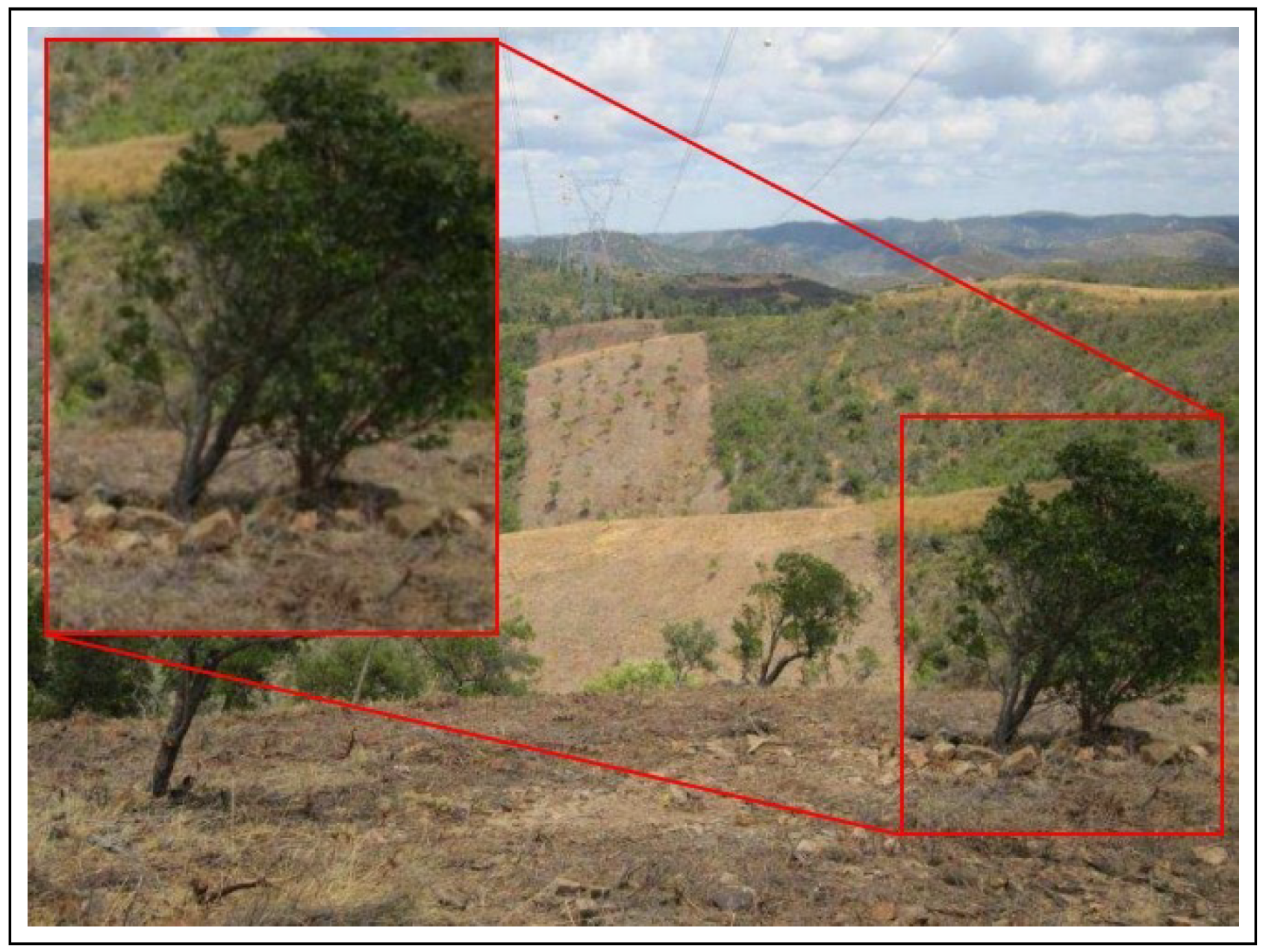

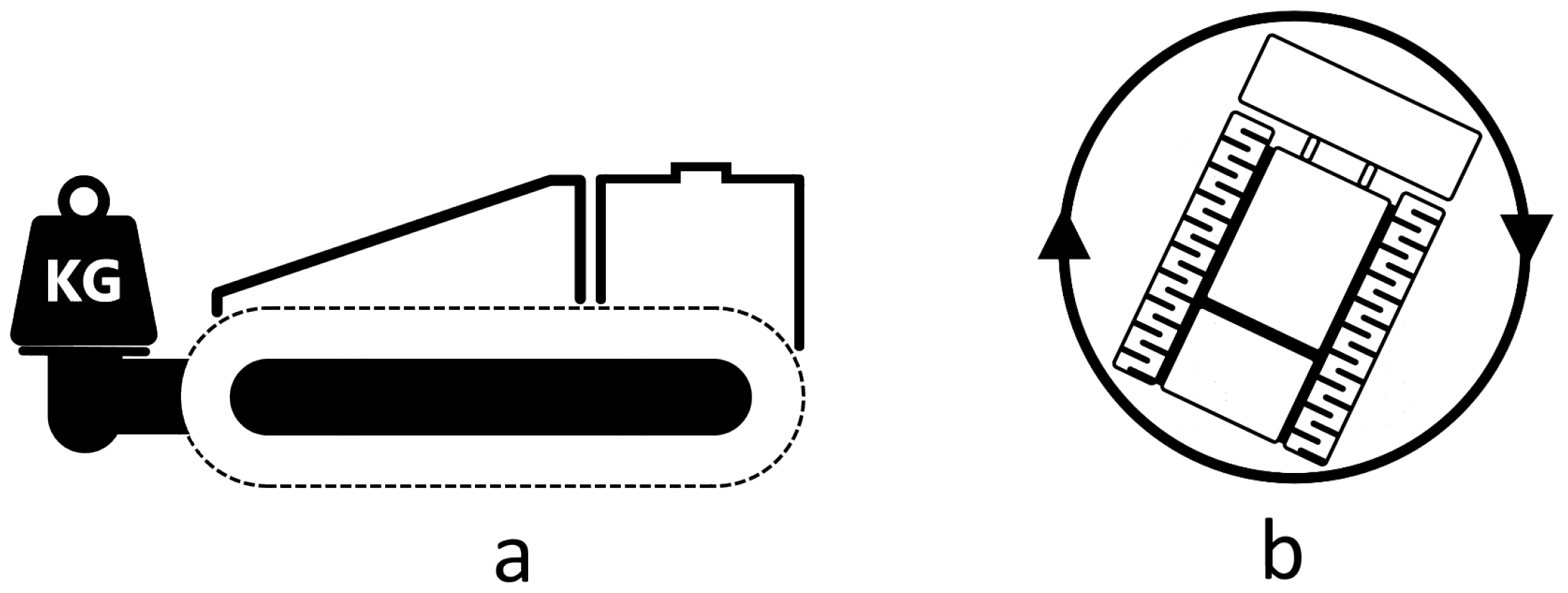




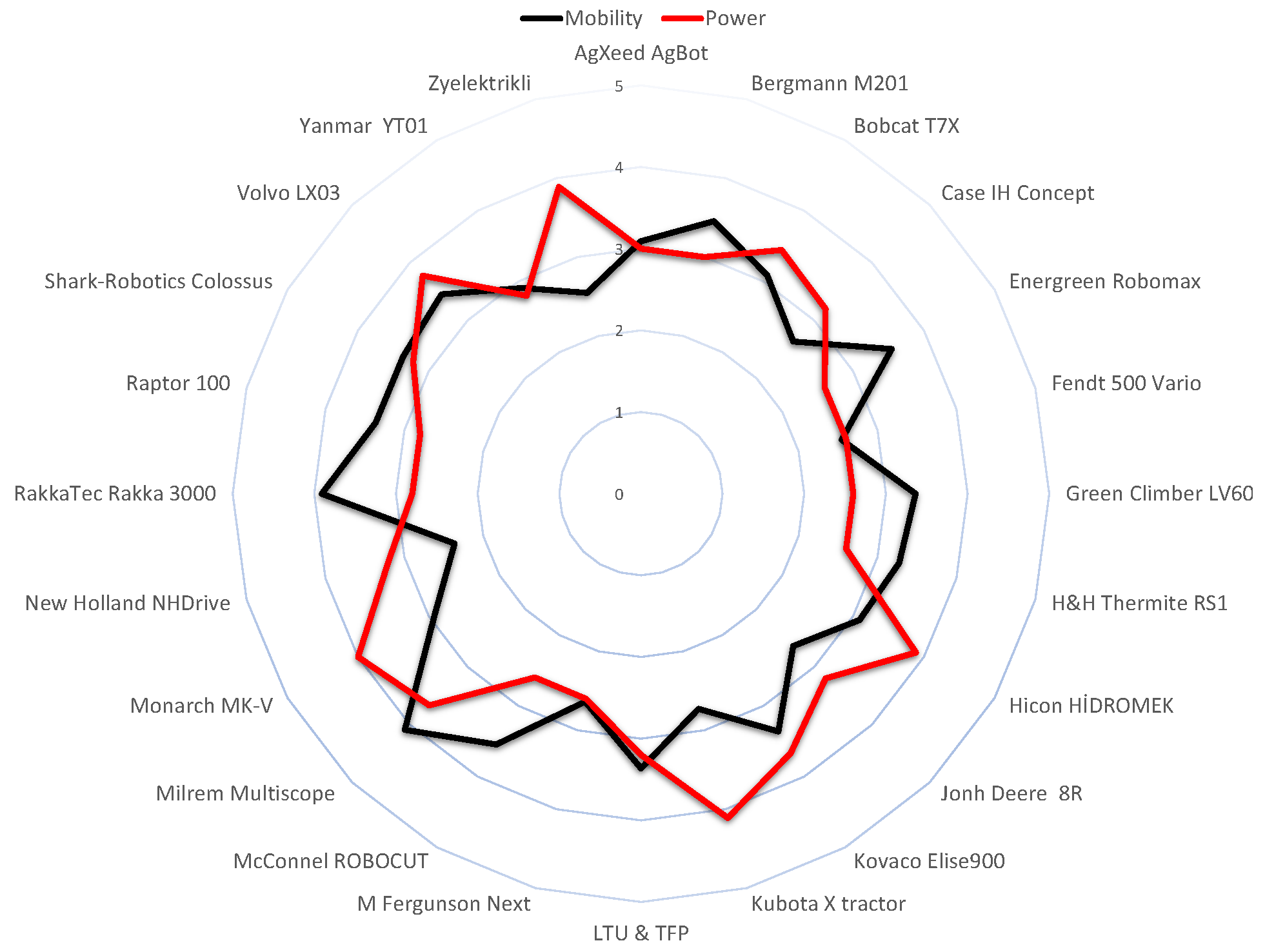

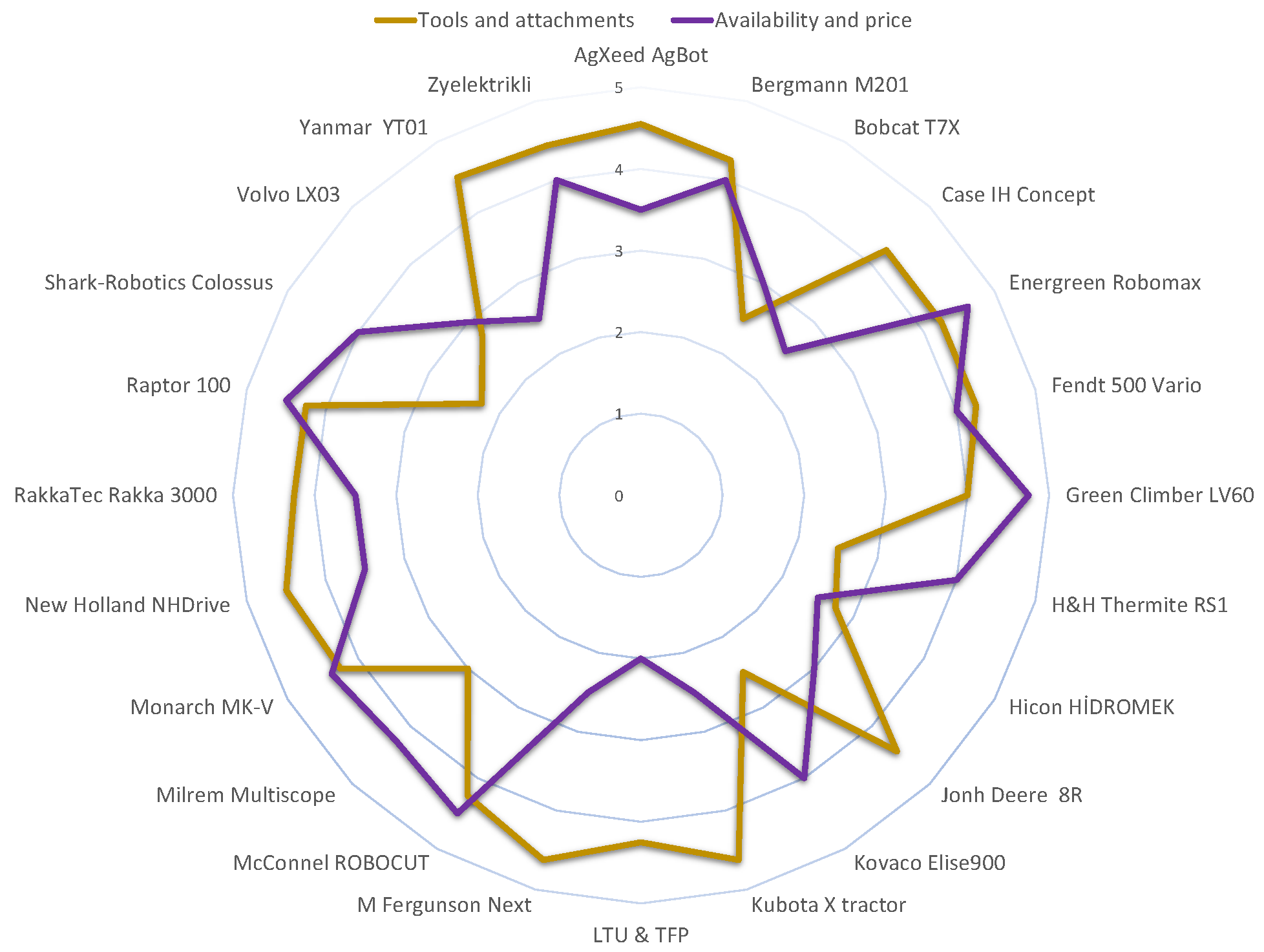
Publisher’s Note: MDPI stays neutral with regard to jurisdictional claims in published maps and institutional affiliations. |
© 2022 by the authors. Licensee MDPI, Basel, Switzerland. This article is an open access article distributed under the terms and conditions of the Creative Commons Attribution (CC BY) license (https://creativecommons.org/licenses/by/4.0/).
Share and Cite
Lourenço, J.L.; Conde Bento, L.; Coimbra, A.P.; De Almeida, A.T. Comparative Evaluation of Mobile Platforms for Non-Structured Environments and Performance Requirements Identification for Forest Clearing Applications. Forests 2022, 13, 1889. https://doi.org/10.3390/f13111889
Lourenço JL, Conde Bento L, Coimbra AP, De Almeida AT. Comparative Evaluation of Mobile Platforms for Non-Structured Environments and Performance Requirements Identification for Forest Clearing Applications. Forests. 2022; 13(11):1889. https://doi.org/10.3390/f13111889
Chicago/Turabian StyleLourenço, João Luís, Luís Conde Bento, António Paulo Coimbra, and Aníbal T. De Almeida. 2022. "Comparative Evaluation of Mobile Platforms for Non-Structured Environments and Performance Requirements Identification for Forest Clearing Applications" Forests 13, no. 11: 1889. https://doi.org/10.3390/f13111889
APA StyleLourenço, J. L., Conde Bento, L., Coimbra, A. P., & De Almeida, A. T. (2022). Comparative Evaluation of Mobile Platforms for Non-Structured Environments and Performance Requirements Identification for Forest Clearing Applications. Forests, 13(11), 1889. https://doi.org/10.3390/f13111889







